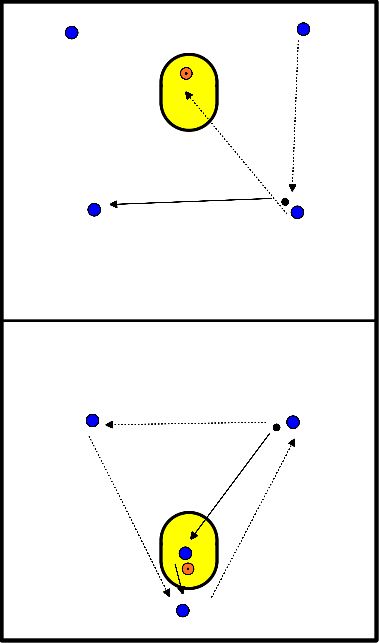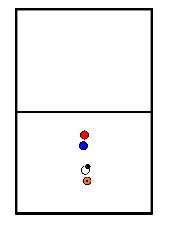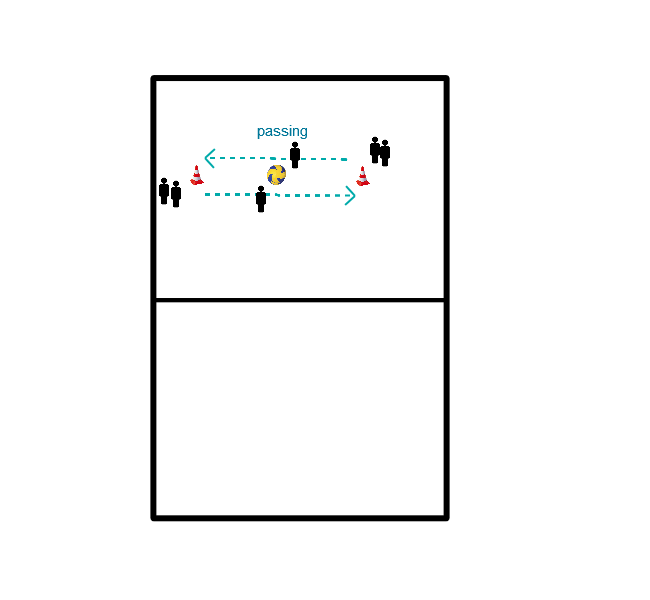Korfball drills
In short: practicing various shooting forms in a fun competition form.
Organization: a post and a ball per group, the posts are preferably (but not absolutely necessary) arranged in a circle or rectangle. Groups 3-3-2
The first task for the groups is to score 10 goals. When you're done with that, the maker of the last goal walks to the trainer to pick up the next assignment. Which group completed all assignments first?
Assignments:
- 5x walk-through balls
- 5x penalty throws
- 3x swerve balls
- 7x short shots
- 4x 4-meter shot
- To finish the training, play a game format of 4 to 4 on 1 post.
- Make sure you build from 4-0, and go to the 3-1 with a large triangle.
- A quick scoring opportunity has to be created from the big triangle.
- If possible, create a scoring opportunity immediately after the rebound has been captured, if this doesn't work then rebuild from 4-0.
- THE BALL PACE IS HIGH IN THE 3-1.

- Pair of two by a pole.
- Each pole has three points.
- If a score is made on a pole, one point is subtracted.
- The pole is defended by a pair.
- The first pair that has zero gets 'a donkey' as an extra point.
- You lost as a pair when you have zero.
- The last pair remaining has won.
- Note: as a pair you are defending your own post but you can be attacked by six opponents.
- It is not allowed to score twice on the same post.
- Group of 3 by a post
- 1 defender, 1 passer and 1 attacker
- the attacker must score as much as possible in 30 seconds
- the defender must ensure that this happens as little as possible

- Pairs of two at a pole.
- Each pole has three points.
- If a score is made on a pole, one point is subtracted.
- The pole is defended by a pair.
- The first pair that has zero gets 'a donkey,' as an extra point.
- You are finished when you have zero as a pair.
- The last pair remaining has won.
- Note: as a pair you are defending your own post but you can be attacked by six opponents.
- It is not allowed to score twice on the same post.
- Two players stand 7 meters in front of the post and eight meters apart.
- A player with the ball under the post and a receiver slightly behind the post.
- One player in front of the post takes the through-ball that is passed, after the other player in front of the post has received the ball.
- The ball is caught by the receiver.
- A1 becomes A2,
- A2 becomes A3,
- A3 becomes A4 and
- A4 becomes A1.
What can you see?
- The passer learns that the shooter can only take a through-ball if the throwing is calmly prepared, is thrown in front of the shooter and the ball is passed at the right height.
- The speed and trajectory of the shooter can be regulated by the speed of throwing, ball trajectory and ball speed.
- Learning to control problems such as timing requires a lot of repetition and sometimes adjustment of the distances used.
- The problems for the shooter, the starting position of the ball is different because the body is twisted for ball reception, lead to impure actions. Stay attentive to this.
- The action speed must be increased.
Variant: - Just like exercise 12, but the passer throws the ball to a shooter who dodges to a position diagonally behind the post.
- There is a ball through the centre where the passer must consider two opponents, his direct opponent and the shooter's opponent, as they are not far from the ball line.
Variant: - The marksman makes a feint shot and passes the ball to the player below the post indicating a through-ball.
- Per group: a post and a ball, the posts are preferably (but not absolutely necessary) arranged in a circle or rectangle.
- The number of persons per group is less important (but all groups are about the same size).
- The first task for the groups is to score 10 goals with a through-ball.
- When you have finished with that, the person who scored the last goal runs to the trainer to get the next task. Which group performed all the tasks first?
- The trainer has a piece of paper with tasks on him.
- When someone comes to get the next task, first ask which task has just been completed (this can vary considerably over time) and then give the next task.
- List:
- 5 through-balls,
- 5 penalty throws,
- Five 3-meter shots,
- 5 shots from 3 meters behind the post.
Create a box with an attacker inside.
- The attacker has to keep moving in the box while a defender is running.
- Someone always plays the ball.
- The defender looks at the ball and tries to catch it
- Every time the attacker catches the ball, someone enters the box.
- When the defender picks up the ball, he throws it back and tries again
- You put up four poles in a square,
- in the middle of the four poles you put down a pilon.
- four children will be passers at the poles and
- the rest of the children will stand by the pilon in the middle.
- First, you can choose that the attackers have to take through-balls at the poles.
- It doesn't matter which pole, they may run at the same pole a maximum of 2 times in a row.
- You can choose this, so they have to run a lot.
- The children also have to score twice, the person who does this first may definitely switch positions with a passer, the other may switch as well as soon as they score twice.
- After that you can choose to let the children do free balls, penalty throws, dodge-balls, etc.

- Put pilons about 6 meters apart. Divide the group into 2.
- In the case of five, one group of 3 and a group of two.
- The goal is to keep the ball in the middle between the pilons at all times.
- As soon as a player receives the ball, the player must be at the centre of the other side.
- After you have passed the ball, you join the back row on the opposite side.
- NB: Nobody stands still and tries to see what happens at all times
- Do not arrive too early or too late.
- Throwing while moving.
- After five minutes switch side (left hand).
- Make pairs, at each post a pair.
- We are now going to use the posts lengthwise, namely one player of the pair attacks the post opposite to him or her.
- One player of the opposite post does the same.
- How does this work?
- Of each pair there is a number 1 and a number 2.
- Number 1 is going to defend his post for a minute and a half against the other number 1 of the post opposite to him.
- When the number 1 of a post has had a chance, the other number will attack and so there will be a change of function (and of post, because everyone is defending his own post).
- So there is always a change of function if the attacker has lost the ball.
- As a player, you are attacking as well as defending for a minute and a half
At a distance of +/- 15 meters from each other, make two compartments with 4 pilons of 1.5 x 1.5 meters.
Make two teams with an equal number of players.
- Each team has its own compartment.
- The other team tries to conquer the other team's square.
- This happens when 1 striker is standing in the opponent's square and the ball is played by a team-mate.
- They get 1 point. No other players are allowed in the box.
- When the defence intercepts the ball, they may immediately start the attack on the opponent's square.
Variation:
- on time
- with points
- of both teams 1 player is allowed in the box
- no limit on the number of defendants in box
- no limit on the number of attackers in box
- customize size of box
- distance between boxes








